Sensor connection issues
Femto Bolt Issues
For issues with Orbbec Femto Bolt sensor, see the Femto Bolt Issues page.
Azure Kinect USB compatibility
The Femto Bolt and Azure Kinect is incompatible with certain types of USB ports. This incompatibility is determined by the chip inside the USB port. More information is available on [Microsoft's Azure Kinect SDK documentation] ().
The Azure Kinect is compatible with the following USB host controllers:
- Intel
- Texas Instruments (TI)
- Renesas
This device is not compatible with some ASMedia USB host controllers, for example ASM1142 chipset.
Unsure of what USB controller you have?
- Connect your sensor to the computer and open the Windows Device Manager.
- Select the Azure Kinect 4K Camera in the Device Manager.
- Under Cameras, select Azure Kinect 4K Camera.
- In the View menu, select "Devices by connection". This will expose the USB host controller that you are using.
Some computers more than one USB host controller. In this case, you can plug the sensor into different USB ports on your computer to understand what you have available.
For desktop computers, we highly recommend installing Startech PEXUSB3S44V USB PCIe Expansion cards, which are tested and validated to work with up to 4 Azure Kinects each. The Renesas Host Controllers found on the Startech PCIe cards come with older Renesas drivers which are incompatible with the Azure Kinect. If the Renesas driver is installed, open the Host Controller in Device Manager and uninstall the device. Windows will automatically install a recent Microsoft driver, which is compatible.
Are you using untested USB ports?Check the of the USB controller to ensure you are using compatible controllers to ensure they are compatible with the Azure Kinect.
- Intel, Texas Instruments (TI), and Renesas USB chipsets are compatible.
- ASMedia chipsets are not compatible.
Learn more in Microsoft's documentation for USB host controller compatibility.
Also ensure that your sensors are plugged into a port where each sensor has its own USB controller. Sharing USB controllers between sensors can cause bottlenecks in the data streams, and and result in dropped frames.
USB extender cables
We recommend using an active USB cable, meaning one that can maintain the data transmission with the help of a powered chip inside the cable. Cables without this chip are considered passive, and should not be used if the cable is longer than a 1.5 meters, as this may result in a drop in performance or power. Please note that not all USB extenders work well with the Azure Kinect.
Azure Kinect power
Though some USB-C to USB-C cable may be able to supply both the power as well as a data connection, not all of this type of cable will work, so we recommend powering the sensor with the included power supply.
If you connect the Azure Kinect to a computer via a USB-A cable, you'll need to with power it separately using the included AC power supply and power cable.
Power Indicator LED
You can verify your USB connectivity and performance with the sensor's power indicator LED, located on the back of the device. See the chart below to learn what these indicators mean.
| Solid white | Sensor is working properly and powered on |
| Flashing white | Sensor is powered on, but may not be connected to a suitable USB port |
| Flashing amber | Sensor is not receiving adequate power |
| Amber + flashing white | Sensor is powered on and updating or being reset |
Azure Kinect not detected in Depthkit, Kinect Viewer, or Windows Device Manager
Multiple sensors connected simultaneously.
When multiple sensors are connected to the same computer at the same moment, some of the sensors may fail to be detected. This can happen if all of the Azure Kinects are powered from the same source, and that power source is turned on while the host computer is already on. You can work around this in either of two ways:
- Disconnect and reconnect each sensor, one at a time, leaving a few seconds between each connection.
- Restart your computer
Azure Kinect "Failed to open device"
If your depth sensor appears in Device Manager but fails to load in Depthkit or the Azure Kinect Viewer, there could be an issue with the Azure Kinect's drivers.
[2023-01-19 16:44:06.375] [error] [t=17720] D:\a\1\s\extern\Azure-Kinect-Sensor-SDK\src\usbcommand\usbcommand.c (370): find_libusb_device(). Unable to open LIBUSB at index 0
[2023-01-19 16:44:06.376] [error] [t=17720] D:\a\1\s\extern\Azure-Kinect-Sensor-SDK\src\color_mcu\color_mcu.c (74): usb_cmd_create(USB_DEVICE_COLOR_IMU_PROCESSOR, device_index, NULL, &colormcu->usb_cmd) returned failure in colormcu_create_by_index()- Verify that your depth sensor is fully powered. You can confirm this with a solid white power indicator LED on the back of the sensor.
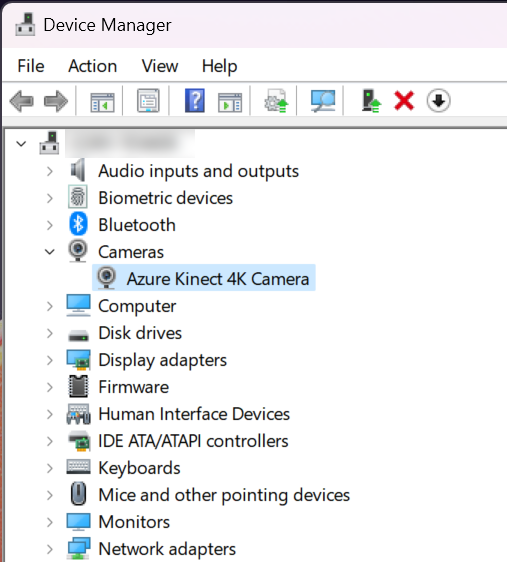
- Open Windows Device Manager.
- Under Cameras, select Azure Kinect 4K Camera. (If you see multiple sensors listed, disconnect all of the other sensor USB connections to ensure you're resetting the correct sensor.)
- With the Azure Kinect 4K Camera selected, in the View Menu, click 'Devices by connection'.
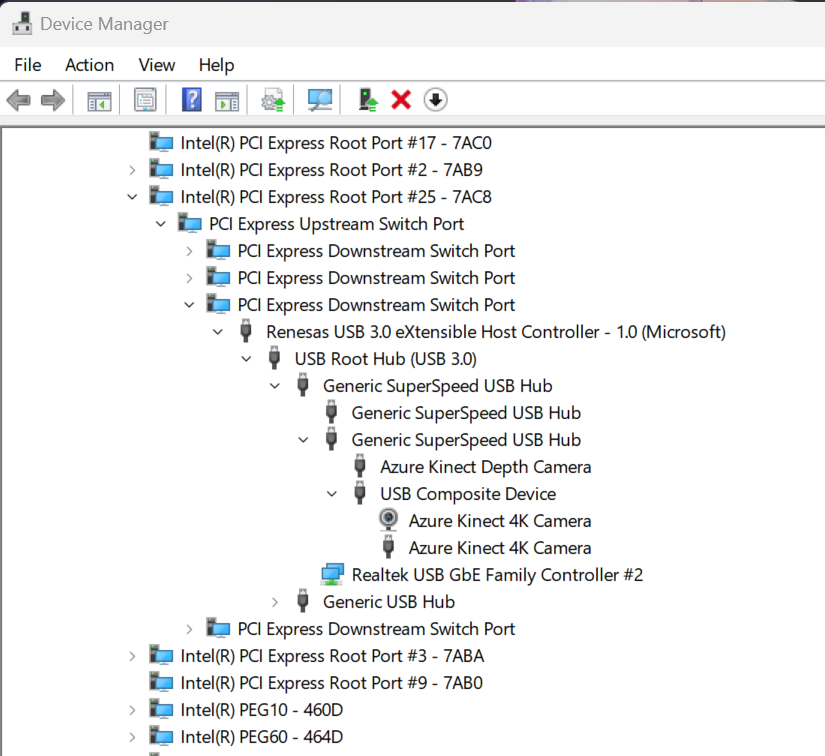
- You should now see a hierarchy of devices as shown above. Expand the Generic USB Hub just below the Azure Kinect 4K Camera to reveal the Azure Kinect Mic Array.

- Right-click the Azure Kinect 4K Camera, and select uninstall device. Confirm by clicking 'Uninstall' in the dialogue box.
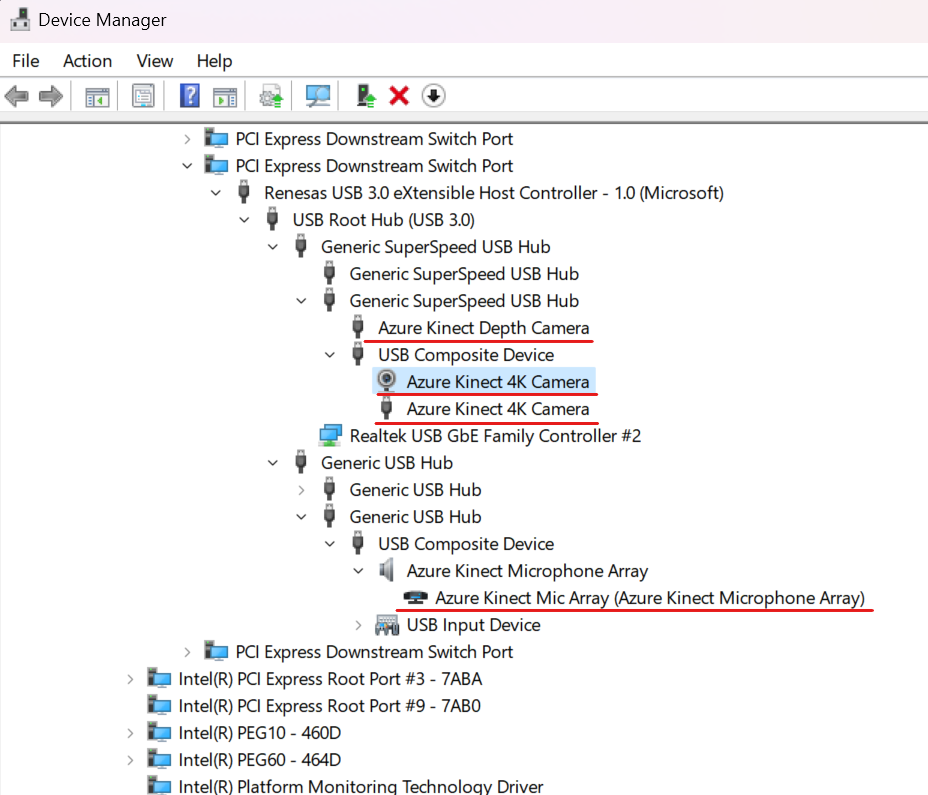
- Repeat this for the Azure Kinect Depth Camera, Azure Kinect 4K Camera, and ** Azure Kinect Mic Array**.
- Restart your computer.
- Windows will automatically re-install the correct drivers for your sensor.
- Ensure your sensor's firmware is up to date.
Kinect v2 USB Compatibility
The Kinect v2 is only compatible with USB 3.0 or faster ports.
Most computers will have a mixture of USB port types and generations. Using the right port is critical when connecting a depth sensor that requires a high data transfer rate, so use a port with the most bandwidth. In most cases, this is a USB 3.0 or USB 3.1 port. Most USB 3.0/3.1 ports are blue, or have a "SS" in the icon next to the port itself.
How do I know which USB ports I have?
On a PC, go to your Device Manager and expand the Universal Serial Bus Controllers section. This will reveal the USB ports available on your computer.
- If your USB port name contains "Universal Host", your port is version 1.1.
- If it contains both "Universal Host" and "Enhanced Host", your port is version 2.0.
- If it contains "USB 3.0", your port is version 3.0.
Here you can right click on each port to learn about type, version, and location of the port.
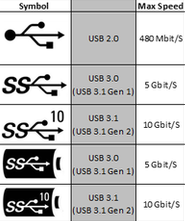
Kinect v2 not detected
-
**Ensure that your sensor is securely plugged in and powered on. **
If it is a power issue, you may want to try plugging it directly into the power outlet in case an extension cable is causing insufficient power. -
**Ensure that you have installed the Kinect SDK. **
If you have not done so, Depthkit will launch, but you will not be able to see depth or color streams. -
Check the performance of your sensor with theKinect Configuration Verifier Tool.
This will give you insight on the state of your sensor connection. Ideally, all categories will be checked and green.
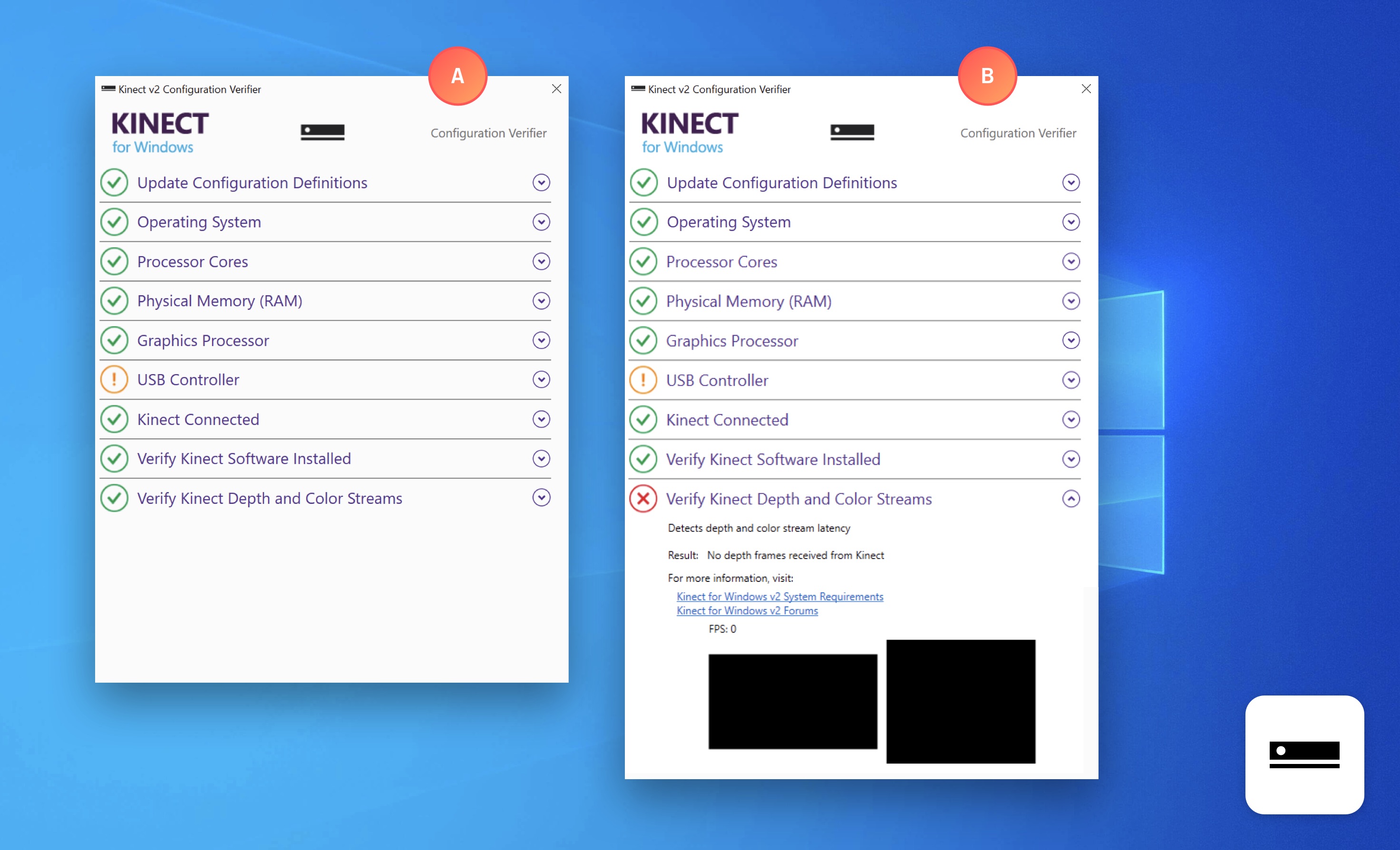
Make sure you have your sensor connected to your computer via a USB-3.1 / USB-C (gen 2) port. Gen 2 ports have a much higher data transfer rate and will promote a more stable connection and data stream from your depth sensor. If you computer does not have a USB 3.1 (gen 2) port, try a USB to USB-C adapter. Learn more about USB ports and how to find which one you are currently using.
You cannot run the Kinect Configuration Verifier while you are running DepthkitYou will find that the depth/color streams may not show up in Depthkit when both apps are active. With this in mind, once your Kinect performance is confirmed, close the verifier before you open Depthkit.
Kinect v2 repeatedly disconnects
First, update your WDF Kinect Sensor Interface driver. You can find this in the Device Manager, under Kinect sensor devices. In the drop down, right-click on WDF KinectSensor Interface and select update driver.
If this does not solve the issue, take a loot at the Performance testing page.
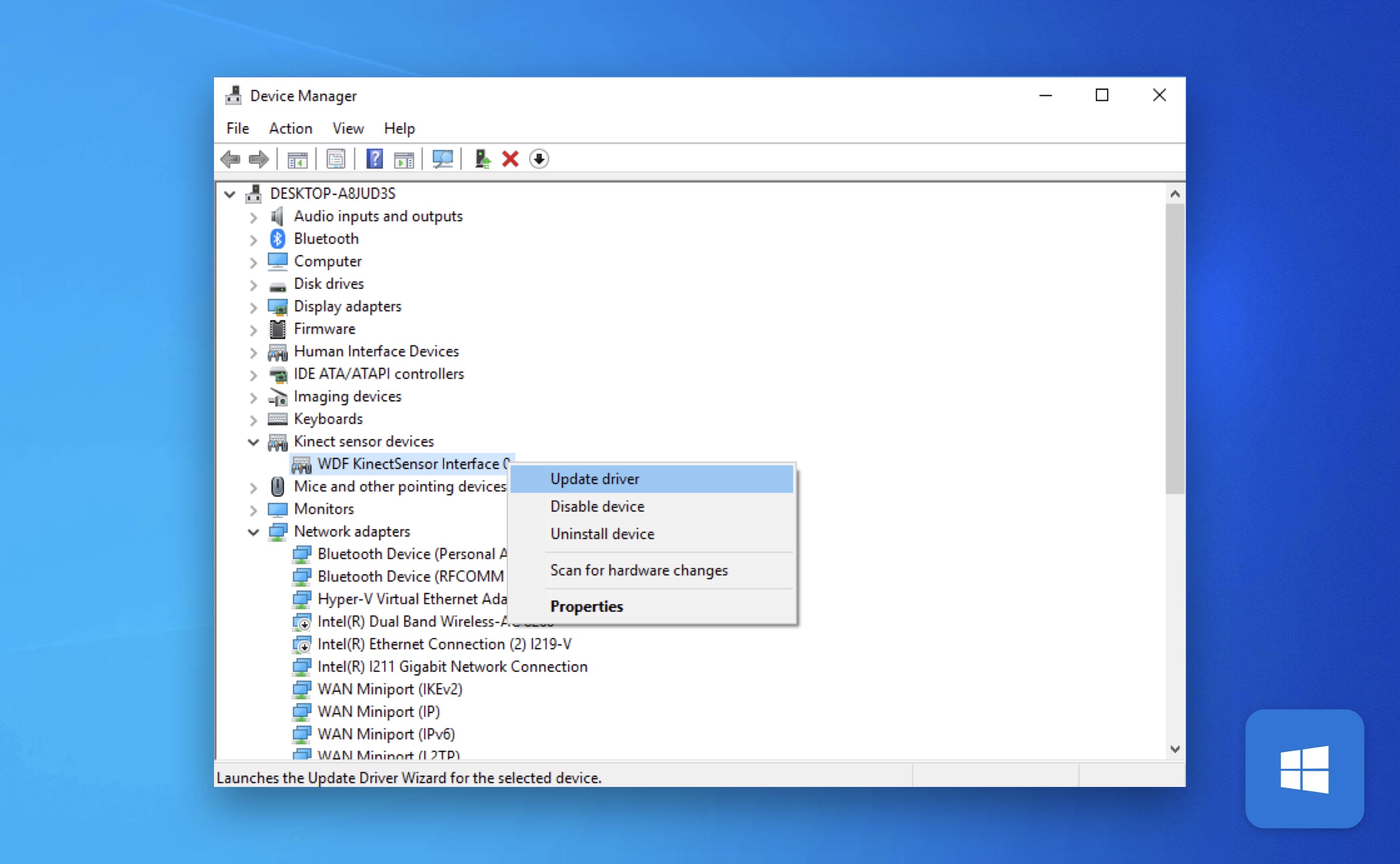
Updated 8 months ago
